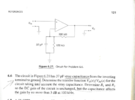RS_Vimperk
New Member
Hello,
i posted the problem as png file.
The first question is to determine the transfer function for the circuit taking into account the stray capacitance. Using voltage-devision rule, i dervied the tf and it was correct, same as the answer at the end of book.
\[ \frac{v_{0}(s)}{v_{in}(s)}= 3.5(1+3.17*10^{-6}s) \]
The second question is to determine R1 and R2 so the DC gain of the circuit is unchanged. What i understand is when DC, then capacitor is open so we get only resistances and since s=0 the transfer function has the value 3.5, and according to this rewriting the formula, we have
R2=2.5 R1
which is also good, the answers at the end of book show that R1=60.2 k, R2=150.6 k
so it's right that R2=2.5 R1
now i'm not sure about that part that says that the capacitance affects the gain by no more than 3 dB at 100 kHz. Can you guide me?
R2 is the feedback resistor.
Thanks.
i posted the problem as png file.
The first question is to determine the transfer function for the circuit taking into account the stray capacitance. Using voltage-devision rule, i dervied the tf and it was correct, same as the answer at the end of book.
\[ \frac{v_{0}(s)}{v_{in}(s)}= 3.5(1+3.17*10^{-6}s) \]
The second question is to determine R1 and R2 so the DC gain of the circuit is unchanged. What i understand is when DC, then capacitor is open so we get only resistances and since s=0 the transfer function has the value 3.5, and according to this rewriting the formula, we have
R2=2.5 R1
which is also good, the answers at the end of book show that R1=60.2 k, R2=150.6 k
so it's right that R2=2.5 R1
now i'm not sure about that part that says that the capacitance affects the gain by no more than 3 dB at 100 kHz. Can you guide me?
R2 is the feedback resistor.
Thanks.


